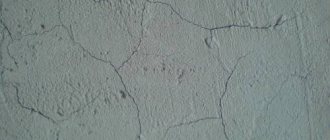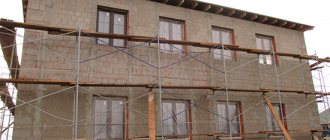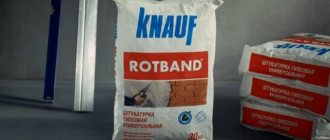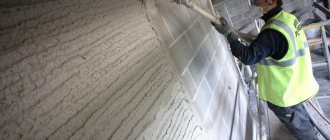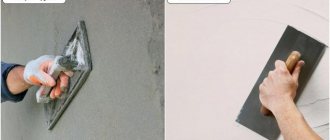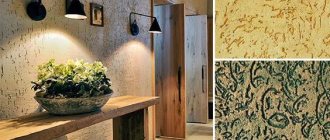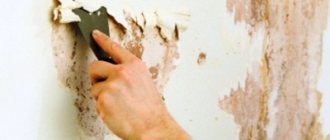How does layer thickness affect drying?
In addition to external conditions, the thickness of the applied layer affects the period of complete drying. The thicker it is, the longer it will take for complete polymerization.
As practice shows, it is better to apply 2-3 thin layers of 1-2 mm each than 1 layer 5-6 mm thick. In this case, it is important to follow the technology: after applying each level, wait until it dries completely, sand it, eliminating any unevenness. Next, a primer is applied and dried thoroughly. Depending on the type of soil, it can take up to 24 hours to dry. Only after this can a new layer of putty be applied.
The process turns out to be longer and extended over time. But the resulting coating will be durable and reliable. There is a guarantee that it will not fall off in a year or two along with the finish.
LiveInternetLiveInternet
- Registration
- Entrance
—Categories
- ***IN THE WORLD OF ANIMALS (411)
- bugs (5)
- animals (59)
- Koteikino (169)
- birds (25)
- fish (8)
- puppy (16)
- lizards, frogs (2)
- ***VEDAS (941)
- aromatherapy (2)
- fortune tellers (42)
- mushrooms (64)
- stone kingdom (25)
- World (94)
- Magic (261)
- Charms and prayers (25)
- oxymomon (209)
- runes and staves (11)
- herbalist (154)
- traditions (44)
- ***SURVIVALS (10)
- ***KIDS (110)
- ***FOR THE SOUL (134)
- ***FOR DIARY (1103)
- clipart (103)
- next buttons (103)
- comments (43)
- tutorials (184)
- congratulations (23)
- dividers (25)
- frames (271)
- themes and schemes (192)
- flash animations (44)
- backgrounds (74)
- photoshop (17)
- epigraphs (23)
- ***FOR COMPUTER (96)
- Internet adventure games (12)
- wallpaper (10)
- programs (11)
- tips (26)
- ***HOME SWEET HOME (297)
- whether in the garden, in the vegetable garden (52)
- decor (37)
- and inside (20)
- repair (13)
- from outside (23)
- flowers at home (85)
- flowers on the street (67)
- ***WONDERFUL PEOPLE (244)
- famous personalities (24)
- stories (25)
- remember - mourn (25)
- ***FINE ARTS (1978)
- illustrations (266)
- pin up (19)
- sculpture, figurines (91)
- sur (29)
- fantasy (58)
- Artists (1514)
- ***HISTORY (242)
- Great Patriotic War (76)
- USSR (38)
- Stalin (21)
- ***MOVIE, MOVIE, MOVIE. (14)
- drama world (62)
- cartoons (19)
- servants of Melpomene (124)
- movie, movie, movie. (38)
- ***BOOKSHELF (709)
- Yevtushenko (25)
- Irina Samarina- Labyrinth (33)
- bookshelf (31)
- radio play (14)
- Rozhdestvensky (18)
- poems (462)
- Eduard Asadov (6)
- Yuri Vizbor (2)
- ***BEAUTY AND HEALTH (518)
- hair (84)
- home pharmacy (239)
- home cosmetics (75)
- beauty terrible power (27)
- manicure (21)
- rejuvenating (45)
- legs (5)
- weight loss (17)
- ***FASHION NEWS (261)
- atelier (164)
- Boho (32)
- stars and mods (2)
- national costume (1)
- shoe (4)
- finishing (16)
- retro (21)
- ***MUSIC (70)
- clips (24)
- let's dance (4)
- let's sing (25)
- ***A LITTLE ABOUT POLITICS (448)
- anti-corruption (58)
- Barmaleyka (2)
- Have an opinion (126)
- reserve (14)
- history (160)
- Konstantin Semin (7)
- Superpower News (5)
- ***POSTRYAPUSHKI (2070)
- without fish and meat (25)
- tasty treats (337)
- twists (157)
- snacks (389)
- gas stations (78)
- m-i-i-yaso (200)
- flour (195)
- drinks (185)
- national cuisine (63)
- R-y-i-bka (43)
- salads (139)
- soup (31)
- cakes (228)
- ***HOLIDAY MOOD (244)
- March 8 (9)
- valentines (11)
- palm (2)
- Maslenitsa (4)
- new year (107)
- Easter (22)
- congratulations (18)
- retro cards (62)
- ***REFLECTIONS ON LIFE (456)
- memories (14)
- funny (82)
- beauty is in simplicity (120)
- Mr Freeman (45)
- wisdom of the people (31)
- way to yourself (111)
- quote book (28)
- ***Handcrafts (1236)
- beads (83)
- embroidery needles (86)
- decoupage (14)
- bunnies (12)
- animals (20)
- quilling (8)
- beauty (221)
- baby dolls (44)
- modeling (19)
- folk crafts (23)
- with your own hands (431)
- creations (208)
- flowers (7)
- jewelry (59)
- ***COUNTRY OF THE SOVIETS (168)
- ***PHOTOS (796)
- interesting (64)
- kaleidoscope (62)
- micro and macro (5)
- worldview (194)
- I like (21)
- still lifes (214)
- photographers (109)
- fractals (11)
- flower garden (103)
- ***JOKE OF HUMOR (192)
- demotivators (16)
- Jewish thoughts (3)
- zestiness (5)
- Odessa residents joke (14)
- purely feminine (23)
—Quote book
2 audiobooks for children.. Wojciechowski S. “Mr. Toomey's Christmas Miracle” “Christmas Miracle.
Scheme “Snowflakes. texture" from Mariella_32
My little “Next” transition buttons. Part 3. My little “Next” transition buttons. Part 3.
My little “Next” transition buttons. Part 4 My little “Next” transition buttons. .
My little “Next” transition buttons. Part 5. My little “Next” transition buttons. Part 5. .
How to determine how long the putty will take to dry?
It is important to note right away that there is no single answer. It is impossible to say that in exactly 24 or 48 hours the walls will be perfectly dried and ready for further work. The process depends on many factors:
- thickness of the applied layer. Builders and finishers - professionals - note that in the classic version, 1 mm of material dries in exactly 1 day, subject to high-quality ventilation and maintaining proper temperature conditions;
- humidity. The optimal indicator is from 50 to 70%. Below: moisture from the surface layer will quickly evaporate. The lower ones will not dry out, and the risk of subsequent pieces falling off and cracks will increase. Above that, the putty simply won’t dry;
- temperature. It is better not to go beyond +50C - +280C. At temperatures approaching zero, all polymerization processes are suspended. The putty remains in its raw form. Very hot weather leads to the opposite result: water evaporates quickly, the required strength is not achieved;
- weather. Heavy rains, bright sun with direct rays hitting the wall being treated, and the presence of strong winds have an unfavorable effect on the drying process. In each case, areas of the surface will dry unevenly. If you take into account that cement putty shrinks, the wall will turn out uneven. The work can begin again.
Influencing factors
The principle of operation of putties is based on changes in their condition and consistency throughout the entire technological process. The dry composition is diluted with water to the required form and applied to the surface. The moisture gradually evaporates, and the putty receives the necessary hardness and strength.
Environment
One of the factors influencing the drying speed of the mixture is the impact of the environment. There are optimal temperature and humidity levels; they were taken into account by manufacturers when designing the compositions of putty mixtures. The ideal temperature range is from + 6 to + 25 degrees.
Carrying out operations at lower temperatures will lead to disruption of the technological process and, as a result, poor quality putty. Curing must take place at the temperature prescribed by the manufacturer. The mixture is enriched with special additives for operation at low temperatures.
Excessively high temperatures also have a detrimental effect on quality; curing will occur quickly but unevenly. The fresh layer is sensitive to direct sunlight. It is recommended to cover recently treated areas with a protective film.
Humidity
Moisture has a direct impact on the quality of surface leveling. To create an ideal layer, the moisture content should not exceed 50%. Increasing the humidity level to 75–80% will significantly increase the drying time of the treated area.
Air permeability
The speed of work without loss of quality is positively influenced by good ventilation of the room. Drafts must be avoided.
The time it takes to dry the putty on the walls depends on several factors:
- thickness and number of layers;
- surface features;
- characteristics of the mixture.
Layer thickness
High-quality putty involves applying many layers of the mixture as thin as possible and allowing them to dry sequentially. The thicker the coating ball and the number of layers, the longer the drying process will take.
Surface
The porosity of the treated surface stimulates increased absorption of liquid, which accelerates the hardening of the putty and leads to its cracking. This can be avoided by pre-priming the work area.
Before starting repairs, you should read the instructions, as they describe in detail the process of applying the leveler and the time required for drying.
Old plaster is often used as a base, so it does not affect the timing of the work. To use fresh plaster in this role, you need to know exactly its drying time.
Actions can only be carried out on a completely dry surface. A layer of fresh plaster 1.5–2 mm thick will be ready in 24 hours at optimal temperature conditions and sufficient ventilation.
A standard layer dries in approximately 7 days depending on thickness. The longer you let the plaster sit, the stronger the base will be. It reaches final strength in 26–28 days.
Each putty has its own characteristics laid down by the manufacturer. They should be taken into account when planning and carrying out repair work.
What is the difference between the materials?
The similarity between plaster and putty is that both building mixtures are used to level various surfaces.
However, with the help of plaster you can level surfaces not only inside, but also outside: it can level fairly large areas and hide very noticeable defects (for example, holes).
Putty, in turn, is used to correct minor problems on the surface (small cracks or seams).
Both building mixtures can be found on sale both in powder form and in a ready-to-use version.
Plaster:
- Creates a protective layer (builders often use it when renovating rooms with high humidity).
- Eliminates noticeable defects.
- Creates a reliable decorative layer.
- Removes large cracks.
- Used for finishing decorative finishing.
Putty:
- Creates perfectly smooth surfaces, which later serve as a base for wallpaper or paint.
- Does not shrink.
- Seals shallow seams and other defects.
- Creates textured surfaces.
- The cost of putty is higher than the cost of plaster.
Why can't it be used in wet areas?
Wet areas include kitchens and bathrooms. Even some manufacturers indicate this on their products, warning the buyer in advance. This kind of relieves them of responsibility so that people don't come and complain. The fact is that this material is capable of absorbing moisture. If there is not enough of it in the room, then the absorbed moisture quickly evaporates from the plaster. But if high humidity is maintained constantly, the condition of the gypsum deteriorates. This can cause it to peel and collapse, especially if there are heavy tiles attached to the top. It is for these reasons that it is not recommended to use it in such rooms.
Dries quickly and without cracking
Alkyd - designed for leveling metal and wooden walls so that they can later be painted. Such mixtures must be used with caution; they are highly toxic. It is advisable to use a respirator when working and ventilate the room in which the work is being carried out.
All mixtures made on the basis of polymers have good characteristics, but their price remains quite high. The drying of such putties largely depends on the layer applied to the surface. With a thickness of no more than 3 mm, they will dry in 3 hours.
First steps. Slab countertops
The first attempts to make something from the brought slabs. Although there may be some attempts, the material costs money and the right to make mistakes is as much as there is money in your pocket. Train at your own expense, as they say.
Therefore, each board is carefully inspected and tried on; the proverb about measure seven times is in action.
The work itself is not tricky, creative, there are several boards and they need to be selected so that they look beautiful and there is no overspending. All sizing and trimming is done with the minimum possible removal of material, simply sawed off a little here, cut a little there with a chisel.
How is puttying done?
Putty can be rough (starting) and finishing:
- The task of the starting option is to level the surface. Apply a layer of up to 6 mm;
- finishing putty prepares the wall for subsequent painting or gluing. Apply with a minimum layer of 1 mm. It is recommended to use polymer compounds. They withstand contact with water well and do not emit harmful substances.
Rough or starting putty is applied only to a completely dried and sanded wall after plastering. For plaster, the time required for drying is calculated using the formula: 1 mm x 1 day.
Varieties
Depending on the type of surfaces being treated, putties vary in composition. They can include a variety of binding components: gypsum, cement, lime with various additives, as well as polymers, such as latex or acrylic.
Gypsum based
When using putty based on this binding element, you must remember the features of using this leveler.
This putty is suitable exclusively for carrying out internal repair work in optimal humidity conditions. The material absorbs liquid from the air, so under damp conditions peeling and crumbling occur.
This is the fastest drying type of putty. During the day, without violating the manufacturer’s instructions, you can apply up to 3 layers of leveler. It takes from 3 to 6 hours to dry one thin ball.
Gypsum putty dries very quickly , which has a positive effect on the overall repair time. But improper planning of batches leads to excessive consumption of material. It just dries up before you can use it up.
The material demonstrates positive adhesive properties and is easy to use.
Cement-lime
Cement compositions have a number of advantages that set them apart from other mixtures. The affordable price of the product, combined with the fantastic strength of the coating, operations in environments with high humidity and the possibility of temperature changes, make this type of processing extremely popular.
The preparation of the base for tiles, porcelain stoneware and stone is carried out with this particular product. The absence of a negative reaction to dampness and low temperatures makes it possible to carry out external work on finishing facades. The putty is excellent for smoothing out slab joints and cracks without reducing the strength of load-bearing structures.
This putty dries in 24 to 48 hours, depending on the thickness of the applied layer and external conditions. The average thickness of the applied layer is 6 mm.
Based on polymer components
Mixtures of this type are universal. They are becoming more common because they can be used for both interior and exterior finishing work. They are absolutely not afraid of moisture and demonstrate excellent elasticity. A solution based on polymer binders, after drying, does not shrink or crack, and is not subject to other types of deformation. In addition to leveling, the mixture has protective functions and can additionally be used to decorate walls. Craftsmen carve chaotically arranged shapes and strokes into the wet putty.
When to slow down the setting
Slowing down the setting of alabaster is important when a large amount of work is being performed and there is no desire to dilute the plaster a hundred times in small portions. For example, you need to seal the grooves throughout the room, but Rotband (a gypsum mixture with polymer additives) is not at hand. You can dilute 100 grams of alabaster, but this volume will be enough for 5 minutes of work. If you use a retarder, then dilute 1-2 kg of material at once and perform a multiple greater amount of work in one approach.
So, the main task of slowing down the setting is to increase the volume of mixing the gypsum mixture and to complete a larger piece of work from one batch .
Acceleration of drying
It is impossible to accurately answer the question, how long will the putty solution take to dry? Since the drying process depends on the external environment, the characteristics of the material used and the thickness and composition of the putty.
Complete drying of the putty mixture, depending on the type:
- gypsum – dries from 3 to 6 hours;
- cement – from 24 to 48 hours;
- polymer – from 4 hours.
Manufacturers do not recommend accelerating the polymerization reaction. Curing must take place according to the technological features of the process.
It is possible and necessary to create optimal conditions for high-quality work.
- It is necessary to maintain the design temperature in the room in the range from +6 to +25 degrees. In the case of using aggressive heating, for example, a hair dryer, uneven drying is inevitable, which ultimately leads to cracks and shedding.
- It is recommended to avoid sudden temperature changes.
- It is necessary to ensure sufficient ventilation to remove excess moisture - but not drafts, as this has a detrimental effect on treated ceilings and walls.
The classic way to speed up repairs is to use quick-drying mixtures. All characteristics and features of putties are described in detail in the instructions. They are often used before wallpapering.
Average drying time for Knauf compounds
It is impossible to give an unambiguous answer to the question of how long it takes for Rotband plaster to dry on walls. It all depends on the conditions in which the composition is applied, on the room temperature and humidity level. Experts say that the optimal conditions for proper setting of the compositions are a temperature of 18 to 22 degrees and a humidity of 8%. In this case, the composition will dry out 2-5 mm in depth per day.
The manufacturer of gypsum plaster talks about the following properties of Knauf products:
- the initial drying time of the layer (up to 8 mm) is about 60 minutes;
- final strength gain - after 7 days;
- operating temperature - range +5...+30 °C.
During the cold season, moisture does not escape from the walls very well, and therefore the start of work on applying putty should be postponed for another couple of days.
Water requirements
For dilution, water is taken from the water supply, the purity of which is guaranteed by the water utility. The rate of chemical reactions in which gypsum binder is involved depends on temperature. Consequently, the temperature of the liquid affects the timing of the onset of setting.
When mixed with cold water, the mixture has a long life; increasing the temperature by 10 ° C can shorten it by 20 minutes.
Water can warm up in a black hose lying in the sun, so do not forget to check the temperature in the container with your hand.
Obtaining guaranteed “German quality” is not achieved only by purchasing material. The plaster mixture must be prepared correctly, according to the manual, where the basics are indicated. In fact, you need to take into account nuances that are not spelled out in the short instructions.
In what cases are Rotband leveling compounds used?
These products are presented in the form of dry mixtures for leveling horizontal and vertical surfaces. Their main component is gypsum, which is characterized by good plasticity and ease of work.
Using plaster, you can level bases whose curvature exceeds 7 cm. For subsequent finishing, the resulting surface is puttied with compounds of the same name. Knowing exactly how long it takes for Rotband to dry, you will be able to complete the work in strict compliance with the technology and begin subsequent work at the right time.
Plaster application process
During the work, professional craftsmen use a rule, but if there is none, you can use a light and even board and a wide metal ruler. If you need to lay a large layer of plaster, first apply the composition to the walls using a regular trowel. Then apply the mixture to the rule and distribute the composition along the wall, applying the tool to the edges of the beacons. This way you will get a perfectly smooth and even surface.
When working with cement compositions, the rule moves only from bottom to top. Gypsum varieties allow the master to work in different directions. However, do not forget how long it takes “Rotband” to dry. You will have no more than 30 minutes to correct errors.
If you need to cover external corners with plaster, use metal corner profiles to improve the quality of work. They simply need to be fixed at the junction of two planes and covered with a working composition. As a result, you will get a properly shaped surface that will be protected from premature wear.
Useful tips for removing putty
On a note:
When you are ready to dilute the putty, study the proportions indicated in the instructions on the package;- You should not mix a lot of mixture in one go, as you may not have time to use it completely before it begins to dry out;
- Once the mixture has set, you cannot add water and mix it again;
- Clean the bucket after each batch of putty; if you do not thoroughly clean the bucket earlier, already dried pieces of putty may get into the next batch and make the next batch useless to use.
You can mix mixtures from different manufacturers. If you do not have the opportunity to purchase putty from expensive brands, in order to decorate the entire apartment, you can add a small amount of it to a cheap base. For example, Knauf Rotband Isogypsum, which contains polymer additives that make the mixture more sticky, can be mixed with Satengypsum in a ratio of 1:3, after which we get an improved putty composition for finishing walls.
How to store prepared plaster in a bucket so that it does not harden
If there is plaster left in the bucket and you want to save it, this is not always possible:
- the finished paste does not harden in its original packaging during the entire shelf life;
- the Vetonit type cement mixture can be left for a couple of days;
- gypsum-based solutions are used immediately and cannot be stored.
The manufacturer indicates in the instructions whether a specific composition can be stored.
Which bucket is best to store it in?
Paste-like packaged plasters are left in their “original” packaging after use. For better sealing, it is advisable to remove the mixture from the rim of the bucket and clean the lid. The container will close tightly and will not allow air or moisture to pass through.
It is permissible to leave the cement mortar in a bucket or basin covered with polyethylene for no more than a day. For long-term storage, the leftovers are placed in a sealed bag and the bag in a bucket with a lid. The closed packaging prevents the cement from drying out.
Where to put a bucket to keep the plaster longer?
Containers with remaining plaster should be stored indoors. Extend the shelf life of the material:
- room temperature;
- normal humidity;
- protection from direct sun rays;
- absence of heating devices nearby.
Certain types of ready-made putties are sensitive to temperatures; storage conditions should be clarified in the instructions.
At what temperature is it best to store
Any plasters do not tolerate heat well. At temperatures above 25 °C, the viscosity increases, the composition thickens and does not adhere well to the surface. Cold also negatively affects the consistency and adhesive properties of the material.
Paste plasters in closed buckets do not require special storage conditions, except for temperatures above +5 °C. Latex mixtures do not harden even at 0 °C.
Required working conditions
If you do not take the application and drying of the putty seriously, then all your work will go to waste. Poorly dried pieces of the mixture may fall off the wall along with the wallpaper. Irregularities may appear that will spoil the appearance of the wall or ceiling, and the applied paint will clearly not be pleasing to the eye. When working with ceramic tiles in the bathroom, careful filling of irregularities and bumps is necessary, otherwise the finish will quickly deteriorate.
In order for the putty drying process to proceed as quickly as possible, but at the same time efficiently, special conditions in the room are required. Therefore, it is recommended to do repairs in the warm season. Thus, the applied layers of the mixture will dry and harden evenly, will not deform, and will adhere well to the wall surface. Among the optimal conditions are:
- Good temperature conditions . Ideally, puttying should be done indoors at a temperature from plus 5 to plus 25 degrees Celsius. If the room is too hot, the mixtures will dry too quickly, which will affect the quality of the work. In the cold, the hardening of the putty not only slows down, but the process itself is disrupted. The applied composition may simply fall off.
- No drafts, but good ventilation. Walls and ceilings will gradually release moisture, which should quickly leave the room.
- Protection from direct sunlight. Unfortunately, the sun can ruin the quality of the work. Therefore, after applying the putty, it is recommended to cover the wall surface with a protective film.
- Humidity in the room. The best option is a 50 percent moisture concentration in the air. If it is larger, then the putty will dry more slowly.
- Thickness of the applied layer . Everything is simple here: the thicker the layer, the slower it dries. Some builders recommend applying the composition to the wall in several layers. They will harden faster, but the work will take a long time.
- Quality of plaster. If it is old, then you can immediately apply the mixture to its surface. In other cases, you should wait until it dries. If there are too large cracks or depressions on the wall, then it is better to plaster the wall first and only then apply the composition.
- Type of putty . As a rule, the packaging already contains the necessary information that you need to familiarize yourself with.
How to dilute liquid putty?
It depends on what kind of putty we are talking about.
The best option if the putty turns out to be liquid is to add the same putty, but only dry, then mix again.
But it is better not to violate the proportions of water and dry mixture, the proportions on the container.
The second option is to thicken the cement putty with cement (dry) and gypsum with gypsum, respectively.
After “thickening”, mix thoroughly again.
You can just wait a little and after a while the gypsum and cement putties begin to thicken and “set” and the more liquid putty will become a little thicker, you can work.
But if in general, that is, there are certain “dangers” in both the addition of cement and the addition of gypsum, the proportions are changed, the quality of the putty will be worse.
For this reason, it is important to dilute the putty correctly right away.
That's right, this is when part of the water is poured into the dry mixture (the total amount is verified), then kneaded using a mixer
You violated the technology, I would not recommend working with such putty if you don’t have the same kind in dry form.
Why does gypsum putty harden too quickly? Is it possible to slow down its setting time, how?
Somehow gypsum putty sets very quickly, why does this happen?
Is it possible to somehow slow down its setting, if so, how?
comment to favorites bonus Kim Jong-un [412K] 2 years ago
In my opinion, if, of course, we are talking about a ready-made dry mixture (putty) to which you only need to add water, you should not use any retarders.
Retarders (any) negatively affect the characteristics of the putty, in particular its strength.
The only correct option is to knead a smaller amount of putty, that is, knead exactly as much as you have time to work out.
And at the same time, observe the proportions of water and dry mixture (information on the packaging).
Further, from personal experience I can add that the correct mixing sequence can also increase the setting time of the putty.
For example, if you first pour putty into a container, and then pour in water, the putty will harden faster if you first add water, then gypsum putty.
If the container for putty is filled with old putty, then this can also affect (negatively) the time it hardens; before mixing again, we clean the container of hundreds of traces of the old hardened putty.
Due to poor-quality mixing, lumps of dry mixture may remain in the putty; they swell over time and the gypsum putty may harden too quickly.
A high-quality knead can only be made with the help of a construction mixer, or a whisk like this
(attachment) for a drill.
It is better not to mix the putty with a trowel.
If you still need some retarders, then you can use PVA glue, wallpaper glue, even liquid soap will do, milk (regular), or immediately buy retarders for gypsum solutions.
The proportions are selected according to the location; if you choose milk, then 10% of the milk from the amount of water in which the putty is mixed.
If PVA, then I usually add it to the water on which the putty is mixed.
Part PVA to about 4 parts water.
Next, pour the putty into a clean container, add water and PVA and mix it with a mixer.
It is also important to take into account the correct preparation of the surface; perhaps you did not properly prepare it for applying putty.
For example, they didn’t prime, or they primed with one layer and that’s not enough.
The wall actively absorbs moisture, hence the problems with putty.
Highly absorbent substrates need to be primed 2-3 times and allowed to dry, and only after that can you begin to putty.
Today in this article I will describe in detail the reasons for the short setting times of gypsum mixtures and reveal some secrets on how to save plaster from disposal.
It’s not so rare that a situation arises when you opened a bag of gypsum mixture, mixed the solution, got ready, for example, to plaster a wall, you even scooped up the solution with a spatula and are trying to apply it. And it hardens right before your eyes, does not smear, or crumbles. In general, something incomprehensible is happening. What is the reason?
The reason for the rapid setting of the gypsum solution lies in the loss of activity of modifying additives, namely retarders, which are introduced into the mixture.
After all, without a retarder, gypsum begins to set within 5-6 minutes after mixing with water. With such a short working time, it is almost impossible to work with the solution when leveling surfaces. And in order to increase the time before setting begins, to make the gypsum mixture more convenient to work with, retarders are added to it. Unfortunately, chemical additives are not stable forever, like sand, for example. They have a limited validity period.
Supplements may lose their potency:
— from long-term storage (i.e. expired product);
- from storage in improper conditions, when high humidity when storing mixtures in craft bags penetrates into the mixture itself;
Kraft bags are just paper. Thick, three-layer, but paper with perforations. It protects against moisture in the short term, but not in the long term.
It’s easy to identify the delay; just check the release date, which is stamped on the side of the bag by the printer. Most gypsum mixtures have a guaranteed shelf life of 12 months. Some brands are even shorter, only 6 months.
But storage conditions in retail outlets are more difficult to check. If the manufacturers’ instructions have been completely violated, then you can notice the bags themselves become moist. This is a sure signal to refuse the purchase. But storage violations are not always so obvious. Therefore, no one is immune from such a situation when the mixture hardens immediately after mixing after 5 minutes. What can be done in this case?
Well, all sorts of sellers, of course, will advise you to throw out the unusable product and buy a new one. And they have it too. Which is quite logical for them, but not for you as a buyer. And if you purchased not a single bag, but for example ten or twenty pieces, what should you do? To just throw it away is a shame, to say the least. Wasteful. It’s not always possible to bother with an exchange.
I will describe the two simplest and most accessible methods for increasing the setting time of the gypsum mixture.
.
Method one. Adding CMC wallpaper glue to the mixture
.
This option has been known since Soviet times, when ready-made modified gypsum plasters in bags did not yet exist in the country and master plasterers themselves prepared the composition based on alabaster and CMC glue. CMC is the most affordable wallpaper adhesive produced on the basis of methyl cellulose. This substance acts as a water-retaining additive and slows down the setting process.
To add glue to the gypsum mixture, it is first mixed in a container for the solution. Let the glue sit, then mix again, bringing the consistency to a liquid state. And already on this water they cast the plaster. The solution turns out to be quite working. 20-30 minutes, depending on the proportions, it maintains mobility. You can already use it as plaster and make more than one bag.
Method two. Adding citric acid.
The acid itself acts as a retarding ingredient. Lemon is simply the most affordable for private owners. You can buy it at the first grocery store you come across. It costs mere pennies, but the benefits of using it are invaluable. You won’t need much of it; the concentration should not exceed 0.1% by weight of the gypsum composition itself. When trying to add it, it is better to start with a half dose of 0.05%, which, translated into the usual measurement, will be 15 grams. Often this is just one cooking bag.
These affordable means can save bags of gypsum plaster from disposal. And you will save your money, and you will not waste your nerves with the exchange in the trading network.
Thank you for reading the article, I hope that you did not regret the minutes spent.
Don't skimp on
liking and reposting if you liked what you read.
If you have any questions, leave them in the comments.
I will be happy to answer you.
If you are interested in other questions, write and ask. I will try to write my recommendations in detail as soon as possible.
Subscribe to my channel.
It is planned to prepare a whole cycle for each group of materials with which I have worked and gained certain experience.
Ways to slow down the setting of gypsum
Each product comes with instructions that must be followed. It is under this condition that the manufacturer guarantees the quality of the product. However, “masters” find ways to improve, or adapt “for themselves,” this or that means. Gypsum putty is no exception.
There are several ways to slow down the setting of gypsum:
- Using glue. Wallpaper (CMC) or wood glue is suitable for this purpose.
- Lemon acid. Using a 0.05% solution of this acid can increase the period of use of the plaster by 30 minutes. If the concentration of the solution is increased to 0.1%, the setting will last for 1 hour.
- Sugar. Adding a 6% granulated sugar solution to plaster also helps to increase the hardening period of the putty. However, it should be noted that this method can affect the strength of the product for the worse.
- Lime. This product is a good retarder. In addition, adding slaked lime makes the putty more flexible. This method is often used when using plaster casting.
- Industrial plasticizers . Construction stores also sell ready-made products that can prolong the setting process of gypsum. Each such product is accompanied by instructions, which indicate the ratio of this product and the main composition, as well as the period for extending the setting. Do not forget that it is better to try any of these methods on a small area, so that later you do not have to do all the work all over again.
And yet, it is better to correctly calculate the amount of mixture that the master can use without the use of various types of retarders and prepare the required amount of putty in several steps.
Preparation of the solution
To prepare the gypsum mixture, add a certain amount of gypsum to the water, stirring continuously. The foam that appears during the preparation of the composition must be removed, as it can make the future product brittle. The thickness of the solution depends on the ratio of the amount of water and gypsum.
Given the high speed of setting of the solution, sometimes it becomes necessary to slow down this process. After all, it is not always convenient to prepare the solution in small portions. And simply adding water to an already prepared mixture can ruin all the work done previously. That is why craftsmen use various compositions to slow down the hardening of gypsum putty.
Important. Gypsum has the ability to expand slightly when hardening.


